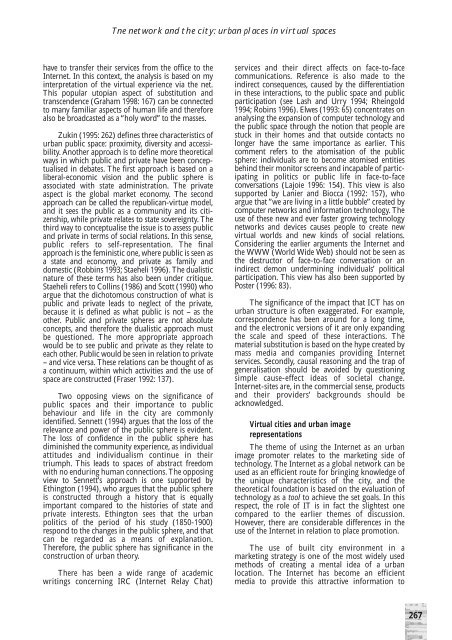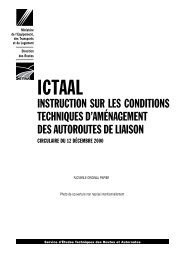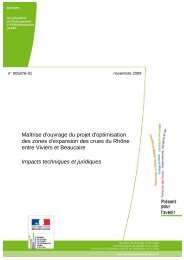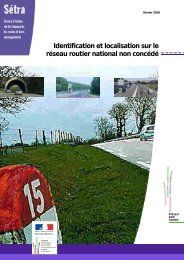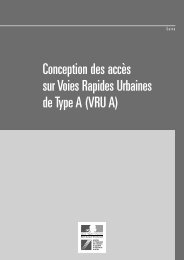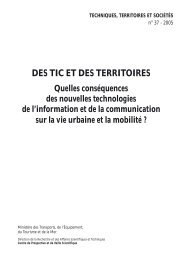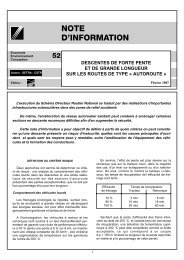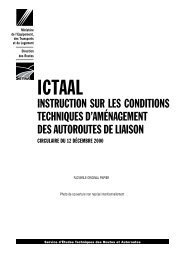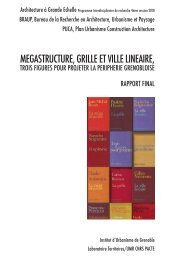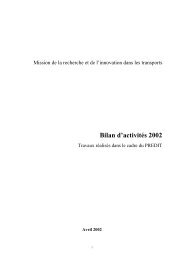Daniel Kaplan - Portail documentaire du Ministère de l'Ecologie
Daniel Kaplan - Portail documentaire du Ministère de l'Ecologie
Daniel Kaplan - Portail documentaire du Ministère de l'Ecologie
Create successful ePaper yourself
Turn your PDF publications into a flip-book with our unique Google optimized e-Paper software.
Tne network and the city: urban places in virtual spaces<br />
have to transfer their services from the office to the<br />
Internet. In this context, the analysis is based on my<br />
interpretation of the virtual experience via the net.<br />
This popular utopian aspect of substitution and<br />
transcen<strong>de</strong>nce (Graham 1998: 167) can be connected<br />
to many familiar aspects of human life and therefore<br />
also be broadcasted as a “holy word” to the masses.<br />
Zukin (1995: 262) <strong>de</strong>fines three characteristics of<br />
urban public space: proximity, diversity and accessibility.<br />
Another approach is to <strong>de</strong>fine more theoretical<br />
ways in which public and private have been conceptualised<br />
in <strong>de</strong>bates. The first approach is based on a<br />
liberal-economic vision and the public sphere is<br />
associated with state administration. The private<br />
aspect is the global market economy. The second<br />
approach can be called the republican-virtue mo<strong>de</strong>l,<br />
and it sees the public as a community and its citizenship,<br />
while private relates to state sovereignty. The<br />
third way to conceptualise the issue is to assess public<br />
and private in terms of social relations. In this sense,<br />
public refers to self-representation. The final<br />
approach is the feministic one, where public is seen as<br />
a state and economy, and private as family and<br />
domestic (Robbins 1993; Staeheli 1996). The <strong>du</strong>alistic<br />
nature of these terms has also been un<strong>de</strong>r critique.<br />
Staeheli refers to Collins (1986) and Scott (1990) who<br />
argue that the dichotomous construction of what is<br />
public and private leads to neglect of the private,<br />
because it is <strong>de</strong>fined as what public is not – as the<br />
other. Public and private spheres are not absolute<br />
concepts, and therefore the <strong>du</strong>alistic approach must<br />
be questioned. The more appropriate approach<br />
would be to see public and private as they relate to<br />
each other. Public would be seen in relation to private<br />
– and vice versa. These relations can be thought of as<br />
a continuum, within which activities and the use of<br />
space are constructed (Fraser 1992: 137).<br />
Two opposing views on the significance of<br />
public spaces and their importance to public<br />
behaviour and life in the city are commonly<br />
i<strong>de</strong>ntified. Sennett (1994) argues that the loss of the<br />
relevance and power of the public sphere is evi<strong>de</strong>nt.<br />
The loss of confi<strong>de</strong>nce in the public sphere has<br />
diminished the community experience, as indivi<strong>du</strong>al<br />
attitu<strong>de</strong>s and indivi<strong>du</strong>alism continue in their<br />
triumph. This leads to spaces of abstract freedom<br />
with no en<strong>du</strong>ring human connections. The opposing<br />
view to Sennett’s approach is one supported by<br />
Ethington (1994), who argues that the public sphere<br />
is constructed through a history that is equally<br />
important compared to the histories of state and<br />
private interests. Ethington sees that the urban<br />
politics of the period of his study (1850-1900)<br />
respond to the changes in the public sphere, and that<br />
can be regar<strong>de</strong>d as a means of explanation.<br />
Therefore, the public sphere has significance in the<br />
construction of urban theory.<br />
There has been a wi<strong>de</strong> range of aca<strong>de</strong>mic<br />
writings concerning IRC (Internet Relay Chat)<br />
services and their direct affects on face-to-face<br />
communications. Reference is also ma<strong>de</strong> to the<br />
indirect consequences, caused by the differentiation<br />
in these interactions, to the public space and public<br />
participation (see Lash and Urry 1994; Rheingold<br />
1994; Robins 1996). Elwes (1993: 65) concentrates on<br />
analysing the expansion of computer technology and<br />
the public space through the notion that people are<br />
stuck in their homes and that outsi<strong>de</strong> contacts no<br />
longer have the same importance as earlier. This<br />
comment refers to the atomisation of the public<br />
sphere: indivi<strong>du</strong>als are to become atomised entities<br />
behind their monitor screens and incapable of participating<br />
in politics or public life in face-to-face<br />
conversations (Lajoie 1996: 154). This view is also<br />
supported by Lanier and Biocca (1992: 157), who<br />
argue that ”we are living in a little bubble” created by<br />
computer networks and information technology. The<br />
use of these new and ever faster growing technology<br />
networks and <strong>de</strong>vices causes people to create new<br />
virtual worlds and new kinds of social relations.<br />
Consi<strong>de</strong>ring the earlier arguments the Internet and<br />
the WWW (World Wi<strong>de</strong> Web) should not be seen as<br />
the <strong>de</strong>structor of face-to-face conversation or an<br />
indirect <strong>de</strong>mon un<strong>de</strong>rmining indivi<strong>du</strong>als’ political<br />
participation. This view has also been supported by<br />
Poster (1996: 83).<br />
The significance of the impact that ICT has on<br />
urban structure is often exaggerated. For example,<br />
correspon<strong>de</strong>nce has been around for a long time,<br />
and the electronic versions of it are only expanding<br />
the scale and speed of these interactions. The<br />
material substitution is based on the hype created by<br />
mass media and companies providing Internet<br />
services. Secondly, causal reasoning and the trap of<br />
generalisation should be avoi<strong>de</strong>d by questioning<br />
simple cause-effect i<strong>de</strong>as of societal change.<br />
Internet-sites are, in the commercial sense, pro<strong>du</strong>cts<br />
and their provi<strong>de</strong>rs’ backgrounds should be<br />
acknowledged.<br />
Virtual cities and urban image<br />
representations<br />
The theme of using the Internet as an urban<br />
image promoter relates to the marketing si<strong>de</strong> of<br />
technology. The Internet as a global network can be<br />
used as an efficient route for bringing knowledge of<br />
the unique characteristics of the city, and the<br />
theoretical foundation is based on the evaluation of<br />
technology as a tool to achieve the set goals. In this<br />
respect, the role of IT is in fact the slightest one<br />
compared to the earlier themes of discussion.<br />
However, there are consi<strong>de</strong>rable differences in the<br />
use of the Internet in relation to place promotion.<br />
The use of built city environment in a<br />
marketing strategy is one of the most wi<strong>de</strong>ly used<br />
methods of creating a mental i<strong>de</strong>a of a urban<br />
location. The Internet has become an efficient<br />
media to provi<strong>de</strong> this attractive information to<br />
267


